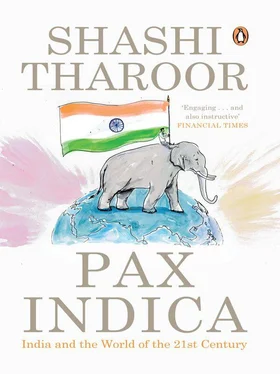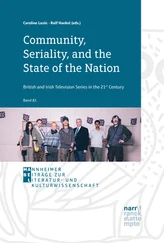The argument for India to be true to its soul in the multilateral arena ought not to be a controversial one, but New Delhi has been notoriously reluctant to preach to others. Centuries of having foreigners telling you what to do and speaking for you abroad, all the while justifying their enslavement of you as part of a ‘civilizing mission’, have created in India a chronic unwillingness to allow the former imperial powers ever to dictate terms to the rest of the world again. This deep-rooted streak (which sometimes comes across as bloody-mindedness to newer generations of Westerners untainted by first-hand experience of colonial domination) will never be entirely overcome until India arrives at a new default stance in favour of liberal democracy through its own internal processes. This may take a generation to occur, as the West needs to understand, but India is undoubtedly heading in that direction.
There are also postmodern questions about nationhood and world order that may need to be confronted in the twenty-first century. The Treaty of Westphalia gave birth to the modern conception of the state, first adopted in Europe and more or less followed by the rest of the world in the post-colonial era. Yet in our increasingly interconnected world we are becoming more and more conscious of how our own ground realities seem to defy the hermetically sealed boundaries of the Westphalian nation state. We live in a region in which Pashtuns straddle Af-Pak, Punjabis and Kashmiris are found on both sides of the India — Pakistan divide, Bengalis across Bangladesh and India, and Tamils in both India and Sri Lanka, to take just a few examples. The time has come for us to think harder about how to deal with the interstices of modern states and pre-modern identities. India can help the world think more wisely about such matters, given that our whole country is a lattice work of interstices. Twentieth-century India was anchored in a dour defence of sovereignty; it is not inconceivable that twenty-first-century India might be better placed to think of connections transcending nation states. It will take imagination and creative diplomacy, two qualities which have not always gone together in New Delhi’s governmental circles. But the future is a different country, and Indians require no visa to go there …

India has, in recent years, witnessed a sea change in the way it treats its diaspora. For some decades after independence, the Government of India kept its distance from the far-flung children of the motherland, making it clear that their obligations lay with their countries of adoption. Even when things went wrong for Indians settled in foreign countries, senior Indians were not averse to delivering lectures to the effect that these no-longer-Indians had made their beds abroad and should learn to lie in them. In the 1980s, however, as a serious cash crunch prompted the government to try and bring home some of the resources of Indians abroad, a new attitude dawned. The hands-off approach gave way to an all-enveloping embrace.
India is now the only country that has an official acronym for its expatriates — NRIs, for ‘Non-Resident Indians’. In my book India: From Midnight to the Millennium , I jokingly suggested that the real debate was whether NRI stood for ‘Not Really Indian’ or ‘Never Relinquished India’. The nearly 25 million people of Indian descent who live abroad fall, of course, into both categories. But the 1600 to 2000 delegates who flock to India from some seventy different countries every year for the Pravasi Bharatiya Divas (Overseas Indian Day) celebrations are firmly in the latter camp. They come to India to affirm their claim to it.
And they come in larger numbers than ever, their enthusiasm undampened by the grim news that litters the Indian newspapers they find upon arrival. Many are not, strictly speaking, NRIs, but PIOs — people of Indian origin now carrying other countries’ passports (both together are subsumed under the label Pravasis). Two presidents of Guyana, vice-presidents of Suriname and Mauritius, prime ministers of Fiji and Trinidad and Tobago, and a former governor-general of New Zealand, are all people of Indian origin who have attended the Pravasi gatherings; so have Malaysian politicians and Gulf-based entrepreneurs, tycoons from Hong Kong and titans from the United States, all united by the simple fact of shared heritage — the undeniable reality that even exiles cannot escape when they look into the mirror. They are united, too, in the words of a typically thoughtful and inspiring inaugural address by Prime Minister Manmohan Singh one year, by an ‘idea of Indianness’. It is an idea that enshrines the diversity and pluralism both of our country and of its diaspora. In a land that is home to Indians of every conceivable caste and creed, the Pravasi Bharatiya Divas celebration affords to Indians — including former Indians — of every conceivable caste and creed the welcome assurance that they are indeed at home.
The Pravasi Bharatiya weekends usually fall on the anniversary of the return to India of the most famous NRI of them all, Mahatma Gandhi, who alighted from his South African ship at Mumbai’s Apollo Bunder port on 9 January 1915. It is curiously appropriate that the event, organized by the newly created Ministry for Overseas Indian Affairs, usually in cooperation with the Federation of Indian Chambers of Commerce and Industry, takes place in different cities each year, as if to embrace the whole country geographically the way in which India seeks to embrace the world with this jamboree.
In his speech to the gathering in 2005, the prime minister traced what he characterized as four waves of Indian emigration: the first, in pre-colonial times, featured Indians leaving our shores as travellers, teachers and traders; the second involved the enforced migration of Indian labour as indentured servants of the British Empire; the third, the tragic displacement of millions by the horrors of Partition; and the fourth, the contemporary phenomenon of skilled Indians seeking opportunity and challenge in our globalized world.
I would probably divide the fourth wave further into two distinct categories: one of highly educated Indians, often staying on after studies abroad in places like the United States, and the other of more modestly qualified but even harder-working migrants, from taxi drivers to shop assistants, who for the most part see their migration as temporary and who remit a larger proportion of their funds home to India than their higher-earning counterparts. But in today’s world both sets of ‘fourth wave’ migrants remain closely connected to the matrbhumi: the ease of communications and travel makes it possible for expatriates to be engaged with the country they left behind in a way that was simply not available to the plantation worker in Mauritius or Guyana a century ago. To tap into this sense of allegiance and loyalty through an organized public gathering was an inspired idea of the previous NDA government, one which the UPA government has built upon through its creation of a ‘one-stop shop’ in the form of a dedicated ministry.
So I have been mildly surprised by the cynicism of the many desi journalists who thrust microphones into my face during these weekends and ask me if it isn’t all a waste of time. ‘What does a conference like this actually achieve?’ they want to know. ‘How is it useful?’ This is a remarkably utilitarian approach to the occasion, and I suppose I could have responded by pointing to the many parallel seminars being run by state governments to attract NRI investment, or the session on disaster management that was added one year in the wake of the tsunami. But I preferred to make a larger point: that sometimes the real value of a conference lies in the conferring. Perhaps it is time we realize that instead of counting how many new millions were raised for tourism in Rajasthan or pledged for reconstruction in Port Blair, we should appreciate how much it means to allow NRIs from sixty-one different lands the chance to share their experiences, celebrate their commonalities, offer their ideas and swap visiting cards. Because when India allows its pravasis to feel at home, it is India itself that is strengthened.
Читать дальше













